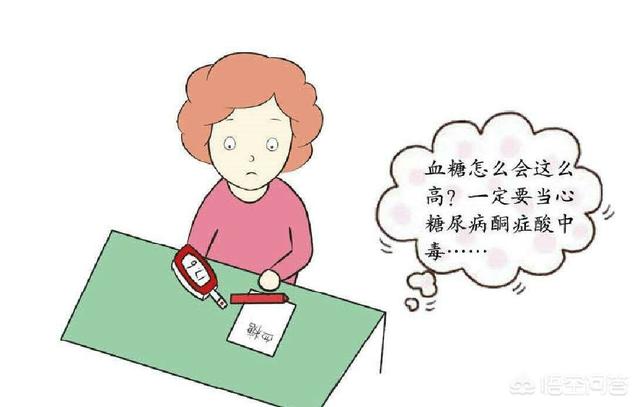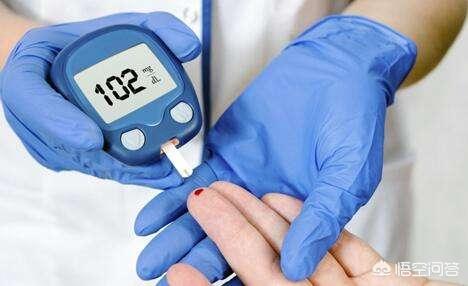What are the dangers of diabetic ketoacidosis?
1. Elevated blood glucose and increased blood ketone bodies have diuretic effect, and a large amount of acid produced in the body will take away a lot of water and electrolytes such as sodium and potassium when discharged with urine, which is very easy to cause dehydration and electrolyte disorders; 2. Acidosis, dehydration and electrolyte disorders can cause neurological dysfunction; 3. In the severe cases, coma, decreased blood pressure, shock, and even death; 4. Ketoacidosis can also lead to the original infection and sepsis further aggravated, and in severe cases can lead to diffuse intravascular coagulation. 5. sepsis further aggravated, and in severe cases, it can lead to diffuse intravascular coagulation.5. On the basis of electrolyte disorders, especially hypokalemia or hyperkalemia, it can often lead to arrhythmia, or even cardiac arrest.6. When the blood glucose and blood sodium drop too quickly, it can in turn lead to cerebral edema, deepening of coma, and a higher rate of disease and death. Acute renal failure is also common.7. Treatment with excessive and rapid rehydration can lead to heart failure;
Diabetic ketoacidosis is an acute condition that can cause coma and even death. The immediate cause of ketoacidosis is an excess of ketone bodies within the blood, which are intermediate metabolites of fat breakdown and include three types: acetoacetic acid, beta-hydroxybutyric acid and acetone. Among them, acetoacetic acid and beta-hydroxybutyric acid are acidic, and accumulating too much blood will lead to acidosis, causing a series of symptoms.
Symptoms of ketoacidosis
Ketoacidosis usually develops slowly, but the appearance of symptoms of vomiting can be life-threatening within hours. It is therefore particularly important to be aware of the early symptoms:
Thirst or very dry mouth;
Frequent urination;
Blood sugar is very high;
Excess ketone bodies in the urine.
Next, the following symptoms will further appear:
The exhaustion was non-stop;
Dry or flushed skin;
Nausea, vomiting, or abdominal pain (vomiting can be caused by a variety of conditions, not just ketoacidosis, but seek medical attention if vomiting lasts more than 2 hours);
Difficulty breathing;
Breathes with a fruity odor;
Difficulty concentrating or disorganized thinking.
Possible complications in treatment
Treating ketoacidosis requires fluids, insulin injections, and electrolytes (e.g., sodium, potassium, and chlorine), and the injection of these items can cause a number of complications, with common problems usually including the following three.
hypoglycemiaInsulin acts as a key to open the doors of the cells, allowing glucose from the blood to enter the cells of the body and bring down blood sugar. The more glucose in the blood that enters the cells, the lower the blood glucose will be which will lead to hypoglycemia.
hypokalemiaThe fluids and insulin injected to treat ketoacidosis can cause potassium levels in the blood to drop, and low potassium disrupts the activity of the heart, muscles, and nerves; a blood potassium level of less than 3.6 is considered to be low potassium, and when the blood potassium level is less than 2.5 it can be life-threatening.
hydrocephalus, to adjust to rapid changes in blood sugar, swelling may occur within the brain and is more common in pediatric patients, especially those newly diagnosed with diabetes.
However, the treatment of diabetic ketoacidosis usually needs to be carried out in the hospital and closely monitored, there are problems that can be dealt with urgently, it is important to cooperate with your healthcare provider, especially do not adjust the dosage of medication without authorization.
The above content is edited and organized by "ask the doctor" for you, want to know more authoritative health knowledge welcome to pay attention to us!
[Etiology]
Diabetic ketoacidosis can occur when there are factors that can aggravate absolute or relative insulin deficiency. The main factors that induce diabetic ketoacidosis include: ① acute infections or acute attacks of chronic infections. ② Interruption of insulin therapy or inappropriate reduction. ③ Inappropriate diet, excessive consumption of high sugar, high fat food or alcohol. ④ Stress, such as trauma, surgery, anesthesia, pregnancy and childbirth, myocardial infarction, cerebrovascular disease, hormone therapy. ⑤ Mental factors such as mental trauma, over-excitement or exertion. ⑥ Insulin resistance, etc. About 10% or so of patients have no obvious triggers.
[Diagnostic Points]
(i) Clinical manifestations
About 90% of patients have a clear history of diabetes. The onset of the disease is usually acute, but there is also a gradual onset of the disease.
1. Exacerbation of diabetes symptoms
Exacerbation of pre-existing symptoms of diabetes, such as polyuria, irritable thirst and excessive drinking, fatigue, muscle aches or weight loss, or only symptoms of infection without other obvious manifestations.
2. Digestive system
Loss of appetite, nausea, vomiting, and in a few cases, abdominal pain, abdominal muscle tension and pressure, cool acute abdomen.
3. Respiratory system
Acidosis manifestation, when the blood pH value is 7.2, the respiratory center is stimulated, manifesting deep and rapid respiration and acidosis respiration. When the blood pH value is lower than 7.0, the respiratory center is paralyzed, and the respiration is weakened, causing respiratory failure and coma. The smell of rotten apples in the expiratory breath is a unique manifestation of diabetic ketoacidosis, which is caused by acetone being excreted from the respiratory tract.
4. Dehydration
Dehydration is almost always present to varying degrees, as evidenced by decreased urine output, dry mucous membranes, poor skin elasticity, softened and sunken eyes, and decreased intraocular pressure.
5. Circulatory failure
A rapid heart rate, weak pulse, drop in blood pressure, drop in body temperature, and finally severe shock, oliguria, and renal failure may occur.
6. Nervous system
In mild cases, there is only dizziness, headache and irritability, while in severe cases, there is apathy, unresponsiveness, impaired consciousness, drowsiness, decreased or absent reflexes and coma.
(ii) Laboratory and ancillary tests
1. Elevated blood glucose, mostly between 16.7mmol/L (300mg/dl) and 33.3mmol/L (600mg/dl).
2. Elevated blood ketones, diagnostic significance when greater than 5 mmol/L.
3. Metabolic acidosis
In the compensated phase, it can be in the normal range. In the loss of compensation the pH is often below 7.35 and carbon dioxide binding ≤ 20 mmol/L. pH below 7.1 and carbon dioxide binding ≤ 10 mmol/L is considered severe acidosis.
4. Electrolyte disorders
Blood sodium and potassium are mostly in the normal range, with a few below normal. Occasionally, blood sodium is elevated, and hyperosmolar syndrome should be suspected if it is greater than 150 mmol/L.
5. Plasma osmolality may be mildly elevated, sometimes to more than 330 mosm/L, which may be associated with hyperosmolar syndrome.
6. Renal function
Urea nitrogen and creatinine are often elevated and can return to normal with treatment.
7. Blood routine
Leukocytes are often elevated, up to 10×109/L or more in the absence of infection, with neutrophil elevation being particularly significant.
8. Positive urine ketone bodies and positive urine sugar.
[First aid and treatment]
The success or failure of the treatment of diabetic ketoacidosis depends largely on the appropriateness of the treatment within the first 4-8h. The principles of treatment are immediate insulin supplementation, rehydration, correction of electrolyte and acid-base imbalance and elimination of the causative factors.
(i) Insulin application
Treatment of diabetic ketoacidosis should be with regular insulin.
At present, small-dose insulin intravenous treatment is advocated. Firstly, saline should be injected intravenously, and normal insulin should be added into the saline, and the dose should be inputted at 4-6U per hour (if the saline is 500ml, and it takes 2h to finish the drip, then 8-12U of normal insulin should be added). 2h later, the blood glucose should be rechecked, and if the drop of the blood glucose is less than 30% of the drop before the drip, then the dosage of insulin should be doubled. If the drop in blood glucose is >30%, continue the drip at the original dose until the drop in blood glucose is ≤13.9 mmol/L (250 mg/dl), then change the saline to 5% dextrose or glucose saline, depending on the level of serum sodium or plasma osmolality. At this time, the dosage of insulin is given according to 2-6 g of sugar to 1 U of insulin, such as adding 4-12 U of regular insulin to 500 ml of 5% dextrose to continue the IV drip. When the patient's blood glucose continues to stabilize, urine glucose ( + ), and ketone bodies disappear, the insulin dosage can be transitioned to conventional therapy. 1h before stopping intravenous insulin, insulin can be injected subcutaneously once with reference to the blood glucose situation at that time.
(ii) Rehydration
Rehydration fluids are commonly used as saline, and certain colloidal fluids such as dextrose and plasma may be given in case of shock. Blood glucose drops to 13.9 mmol/L, 5% glucose solution should be given. If the patient's cardiac function is normal, the beginning of rehydration should be fast, and 1000~2000ml should be input in 2h, and then the rate of infusion should be adjusted according to the blood pressure, heart rate, urine volume per hour, and peripheral circulation. About 1000~2000ml should be input in the 2nd~6h, and the total amount of infusion in the first day is about 4000~6000ml.The daily infusion volume of severe dehydration can reach 6000~8000ml.The infusion rate and the volume of rehydration should be adjusted for the elderly patients or patients accompanied by cardiac insufficiency.
(iii) Correction of electrolyte and acid-base imbalances
1.补钾
Potassium supplementation should be prophylactic during the whole treatment process, so that the blood potassium can be maintained above 3.5 mmol/L as far as possible. If the patient's renal function is still good, the blood potassium is normal before treatment, and the hourly urine output is above 40ml, potassium supplementation can be started at the same time of infusion and insulin treatment. The amount of potassium supplementation in the first 2~4h is 13~20mmol of intravenous potassium per hour (about 1.0~1.5g of potassium chloride). If the hourly urine output is less than 30ml, it is advisable to suspend potassium supplementation, and then start potassium supplementation after the urine output increases.The total amount of potassium chloride in 24h is 6~8g.When the condition is stable and the patient is able to eat, it will be changed to oral potassium supplementation, 3~6g/d.
2. Alkaline supplementation
For mild to moderate acidosis, no additional alkali supplementation is needed. For severe acidosis, the amount of alkali supplementation should be appropriate. The indications for alkali supplementation are blood pH≤7.1 or CO2CP≤10mmol/L. Dosage of alkali supplementation: the first time, give 5% sodium bicarbonate 100ml intravenous drip. Later, the dosage should be decided according to the pH and CO2CP, and the supplementation of alkali should be stopped when the pH is restored to 7.1 or the CO2CP is above 15mmol/L. Hypokalemia should be prevented during alkali supplementation.
(iv) Elimination of causal factors
There are many triggers for this disease, and the common triggers are various infections, especially respiratory, urinary and skin infections, which should be controlled by timely administration of antibiotics. At the same time actively eliminate the negative impact of other factors.
(v) Active management of complications
1. Shock
If shock is not corrected by rapid infusion, the cause should be examined in detail, attention should be paid to whether there is a combination of infection or acute myocardial infarction, and appropriate treatment should be given.
2. Infection
It is a common trigger for the disease and can be secondary to it. It should be treated aggressively.
3. Heart failure, arrhythmia
In the elderly or those with combined coronary artery disease, too much rehydration can lead to heart failure. The volume and rate of fluid infusion can be adjusted according to blood pressure, heart rate, central venous pressure and urine output, and diuretics and positive inotropic agents can be applied as needed. Too low or too high blood potassium can cause serious cardiac arrhythmia, it is advisable to adjust the treatment in time.
4. Cerebral edema
Cerebral edema is related to cerebral hypoxia, too early and too much alkali supplementation, and too rapid drop of blood glucose. If after treatment, blood glucose drops, acidosis improves, but coma worsens, or although awake for a while, but irritable, fast heart rate, high blood pressure, increased muscle tone, should be alert to the possibility of cerebral edema, can be used to dehydrate, furosemide, and dexamethasone and other treatments. Once cerebral edema occurs, the mortality rate is very high.
5. Renal failure
Acute renal failure can be caused by excessive degree of water loss and shock, prolonged duration, original renal pathology, and delayed treatment. It is one of the main causes of death in this disease, and once it occurs, hemodialysis treatment can be considered.
Diabetic ketoacidosis is a harmful complication, is one of the common emergencies in internal medicine, patients need to pay great attention to, actively do a good job of disease prevention and treatment. So, what are the dangers of diabetic ketoacidosis? Here we talk about.
The dangers of diabetic ketoacidosis include four main areas:
1, cardiovascular hazards: acid-base imbalance in the body jeopardizes the heart caused by rapid heart rate, arrhythmia, serious cases can occur heart failure.
2, kidney harm: diabetic ketoacidosis leads to insufficient blood volume, resulting in renal failure.
3, electrolyte disorders: elevated blood glucose and blood ketone bodies increase, have diuretic effect, the body produces a large number of acidic substances, with the urinary discharge to take away a lot of water and sodium, potassium and other electrolytes, very easy to cause dehydration and electrolyte disorders.
4. Neurological hazards: on the basis of electrolyte disorders, especially hypokalemia or hyperkalemia, it often leads to hypoxia and dehydration of brain cells, resulting in coma, or arrhythmia, or even cardiac arrest.
Diabetic ketoacidosis can be caused by no more than three things:
1. Acute infection. Acute infection is an important cause of diabetic ketoacidosis, including the respiratory system, urinary system and skin infections are common, and the incidence is higher in winter and spring. Acute infections can be a comorbidity of diabetic ketoacidosis, and diabetic ketoacidosis is a cause and effect of each other, forming a vicious circle, increasing the complexity of diagnosis and treatment.
2. Improper treatment. Such as interruption of drug (especially insulin) treatment, insufficient dosage and drug resistance. Especially type 1 diabetes patients stop or reduce the dose of insulin therapy, often can cause diabetic ketoacidosis. type 2 diabetes patients take a large amount of long-term phenyl ethylguanidine, especially when liver and kidney function is not good, easy to induce diabetic ketoacidosis.
3. Dietary control and/or gastrointestinal diseases. Such as eating too much, too sweet (too much sugar) or not enough, alcoholism, vomiting, diarrhea, etc., will aggravate the metabolic disorders and induce diabetic ketoacidosis.
So, how do you prevent diabetic ketoacidosis?
1. In the treatment of diabetes mellitus, it should be emphasized that the requirement of a strict insulin treatment regime should not be interrupted or the dose of insulin should not be reduced arbitrarily, regardless of whether it is type 1 or type 2 diabetes mellitus, and that even during the period of illness, such as fever, anorexia, nausea, vomiting, etc., insulin treatment should not be discontinued or interrupted because of low intake of food.
2, diabetes mellitus combined with mild infection, out-of-hospital treatment, should be careful to monitor blood glucose, blood ketones or urine ketone bodies.
3, combined with acute myocardial infarction, surgical acute abdominal surgery and severe infection, should be given timely insulin therapy, severe type 2 diabetes mellitus with oral hypoglycemic drug failure, should be promptly switched to insulin therapy to prevent ketosis.

Click on the bottom of the page [Learn More] to see more answers or ask the doctor a question for free!
Follow "Family Doctor Online" headline, more health Q&A easy to see~~~~
Thanks for the invitation!
Diabetic ketoacidosis is an acute complication of diabetes.
Since diabetics do not have enough insulin in their bodies to utilize glucose, blood sugar rises dramatically, causing an increase in urinary glucose excretion. At this time, the body will use the adipose tissue to produce energy, fat in the decomposition of the ketone bodies can not be well used, it will be accumulated in the blood, resulting in ketoacidosis, water, electrolytes will also increase.

Diabetic ketoacidosis is characterized by...
The patient is hyperglycemic, dehydrated, breathes deeply and quickly, exhales gas that smells like rotten apples, has lowered blood pressure, and, in severe cases, can fall into a coma and experience a life-threatening loss of consciousness.

Risks of diabetic ketoacidosis.
1, ketoacidosis, will make the blood sugar rise, water, electrolyte disorders, so that the nerve dysfunction
2, ketoacidosis can also lead to pre-existing infections and sepsis aggravation, and in severe cases, can lead to arrhythmia and cardiac arrest.
3, ketoacidosis severe cases lead to lower blood pressure, shock, or life-threatening.

Diabetic ketoacidosis is usually prone to occur in patients with type I diabetes, for example, when there is an interruption in treatment, insufficient dosage or resistance develops. Of course, it can also be manifested in patients with type II diabetes mellitus, for example, it is easily induced by taking large quantities of phenacetin for a long period of time, especially in the case of hepatic and renal insufficiency.
Some patients who are diagnosed with diabetes do not pay attention to it, in their perception, diabetes does not affect eating or drinking, and is a relatively mild disease. But this is not the case. Some acute complications of diabetes can lead to sudden death, and diabetic ketoacidosis is one such case.
In the population of type 1 diabetics with absolute insulin deficiency or type 2 diabetics with severely suboptimal lifestyle control, the body's utilization of glucose is impaired due to abnormally high blood glucose levels in the body.
In order to maintain the body's energy supply, the body will compensate for the breakdown of fat and muscle to maintain the body's needs, in this case there will be a relatively large number of acidic metabolites, when these metabolites build up, there will be local irritation as well as an imbalance in electrolyte acidity and alkalinity, and when the PH value reaches the level of acidosis, it will enter into the stage of diabetic ketoacidosis, which, if not treated in a standardized manner, can lead to multiple systemic organ damage.
Initially, the nervous system is predominantly excitable, and in the terminal phase it can show inhibitory symptoms, which can be severe enough to lead to coma. In the gastrointestinal tract the early stages can be characterized by nausea and vomiting, and in the severe stages can be characterized by an inhibitory state showing a decrease in intestinal peristalsis. For the muscles, often the patient will appear more obvious acidic irritative changes.
The standardized treatment of diabetic gouty acidosis is actually relatively simple, requiring only a small dose of insulin combined with rehydration, and the symptoms will gradually recover. For their own safety, it is recommended that diabetic patients increase their knowledge to avoid serious complications.
Find this article useful, feel free to like or recommend to friends and follow[MEDLINE MEDIA]。
Diabetic ketoacidosis is one of the crises of hyperglycemia and one of the acute complications of diabetes mellitus, abbreviated (DKA) .
It is classified as mild, moderate and severe. The harm to the patient is progressive and comprehensive. Mainly.
1. Acidosis. In severe cases, it can lead to paralysis of the respiratory center, severe muscle weakness, and even death.
2. Severe water loss. This can lead to hypovolemia, drop in blood pressure and even circulatory failure.
3. Disrupting the electrolyte balance to make it disturbed. For example, hyponatremia, hypophosphatemia, hyperkalemia.
4. Circulatory failure and renal failure. For example, acute kidney injury occurs in hypovolemic shock, where hypotension leads to oliguria and anuria.
5. Central nervous system dysfunction. For example, drowsiness, coma and even cerebral edema. (Image from the web)
(Image from the web)
General presentation, most patients have polyuria, irritable thirst, excessive drinking, and increased weakness. --Loss of appetite, nausea, vomiting often accompanied by headache irritability, drowsiness, etc., breathing deep and fast, smell of rotten apples (acetone odor). --Severe water loss, decreased urine output, dry skin and mucous membranes, collapsed eyes, rapid and weak pulse, decreased blood pressure, cold extremities - various reflexes are sluggish or absent, coma
All pathophysiologic changes caused by ketoacidosis can be reversed with prompt and correct treatment.

Diabetic ketoacidosis (DKA) is a common acute medical complication of diabetes mellitus, which can lead to coma or even death.DKA refers to a series of pathological syndromes (including hyperketonuria, ketonuria, electrolyte disorders, dehydration, metabolic acidosis, etc.) that occur in diabetes mellitus patients with markedly low levels of insulin, which leads to an over-expansion of the levels of glucagon, and ultimately causes a series of pathological changes.

What are the dangers of DKA? First, gastrointestinal symptoms.In the compensatory stage of DKA, the symptoms of excessive drinking, excessive urination, thirst, and fatigue that diabetic patients already have will be aggravated. With the development of the disease, poor appetite, nausea and vomiting or even inability to eat and drink. A small percentage of patients may also experience acute widespread abdominal pain, accompanied by positive signs of abdominal muscle tension and diminished bowel sounds. Secondly, DKA patients may experience "Kussmaul respiration", i.e., deeper and faster breathing, which may even result in respiratory paralysis. Thirdly, many patients with moderate or severe diabetic acidosis are often dehydrated and show a series of symptoms and signs, such as dry, inelastic skin, cheeks, sunken eyes, etc. Even some patients suffer from circulatory failure and even life-threatening. Fourthly, the patient will suffer from consciousness disorder. In the early stage, the main symptoms are mental disorder, restlessness, dizziness, headache and/or drowsiness, etc. With the development of the disease, drowsiness and coma will gradually appear, which will cause various adverse effects on human brain tissue (such as cerebral edema, etc.). Fifthly, it may cause patients to suffer from arrhythmia or even cardiac arrest, which may affect the heart function.

DKA has a tendency to recur, and patients should always be vigilant and try to avoid its triggers. If an infection occurs, the patient should cooperate with the doctor for active treatment to prevent further development of the disease.
Welcome to Apricot Island for more useful health knowledge.
refer the title or subject (in an online forum)
Before answering the question, let's recognize ketoacidosis. Fatty acids are broken down in the liver into acetoacetic acid, B hydroxybutyric acid and acetone, collectively known as ketone bodies. Ketone bodies are produced very rarely under normal conditions and are detectable in the blood and undetectable in the urine. They are mainly supplied to the heart, liver and kidneys for energy use. In starvation, pregnancy, insulin deficiency, infection stress, fatty acid decomposition in the liver, producing ketonemia, ketone bodies can be detected in the urine, because acetoacetic acid, B hydroxybutyric acid is an acidic substance, leading to body acidosis, called ketoacidosis.
Diabetic ketoacidosis is an acute complication of diabetes mellitus, before the application of small-dose insulin, the morbidity and mortality rate is more than 50%, contemporary medical treatment measures using small-dose insulin drip ketoacidosis, the morbidity and mortality rate is greatly reduced. To say that the danger of ketoacidosis is the loss of life and property.
There are several key points in the prevention of diabetic ketoacidosis, hope to attract the attention of diabetic patients.1, in the use of insulin in diabetic patients, do not casually stop using insulin.2, the diet should be timed and quantitative.3, to prevent infection. Once an infection occurs, go to the hospital in a timely manner. 4, go out with a diabetic warning card to remind passers-by or the doctor to timely and correctly rescue, to ensure the safety of life!
Experience Sharing. Twenty years of diabetes. Ketoacidosis. US 911, one of the top five medical schools in the world, Stanford and UCSF. It can be fatal and crippling to the arms and legs. I injured my brain, causing loss of balance. Chemecle imbalance.
This question and answer are from the site users, does not represent the position of the site, such as infringement, please contact the administrator to delete.